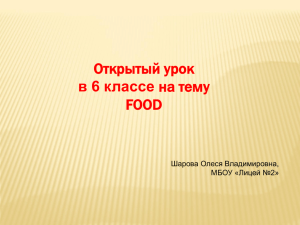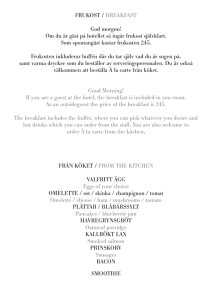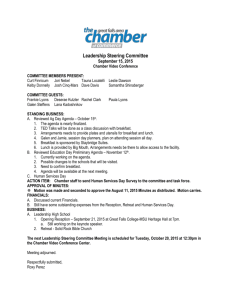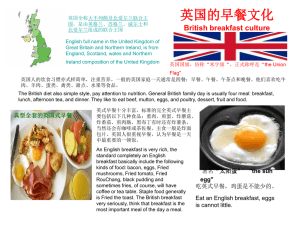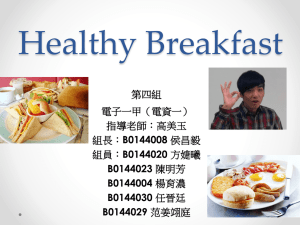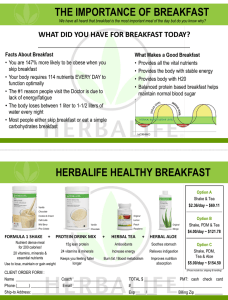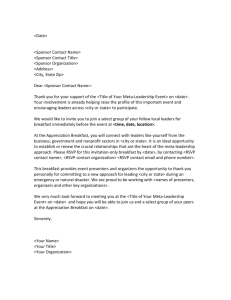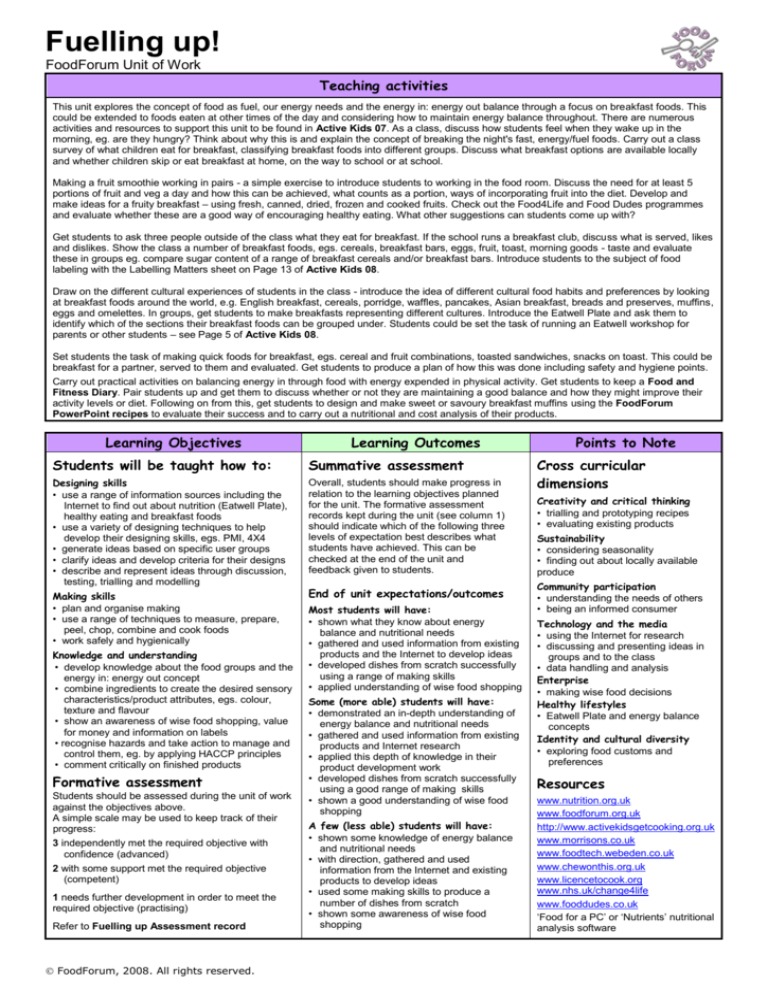
Fuelling up!
FoodForum Unit of Work
Teaching activities
This unit explores the concept of food as fuel, our energy needs and the energy in: energy out balance through a focus on breakfast foods. This
could be extended to foods eaten at other times of the day and considering how to maintain energy balance throughout. There are numerous
activities and resources to support this unit to be found in Active Kids 07. As a class, discuss how students feel when they wake up in the
morning, eg. are they hungry? Think about why this is and explain the concept of breaking the night's fast, energy/fuel foods. Carry out a class
survey of what children eat for breakfast, classifying breakfast foods into different groups. Discuss what breakfast options are available locally
and whether children skip or eat breakfast at home, on the way to school or at school.
Making a fruit smoothie working in pairs - a simple exercise to introduce students to working in the food room. Discuss the need for at least 5
portions of fruit and veg a day and how this can be achieved, what counts as a portion, ways of incorporating fruit into the diet. Develop and
make ideas for a fruity breakfast – using fresh, canned, dried, frozen and cooked fruits. Check out the Food4Life and Food Dudes programmes
and evaluate whether these are a good way of encouraging healthy eating. What other suggestions can students come up with?
Get students to ask three people outside of the class what they eat for breakfast. If the school runs a breakfast club, discuss what is served, likes
and dislikes. Show the class a number of breakfast foods, egs. cereals, breakfast bars, eggs, fruit, toast, morning goods - taste and evaluate
these in groups eg. compare sugar content of a range of breakfast cereals and/or breakfast bars. Introduce students to the subject of food
labeling with the Labelling Matters sheet on Page 13 of Active Kids 08.
Draw on the different cultural experiences of students in the class - introduce the idea of different cultural food habits and preferences by looking
at breakfast foods around the world, e.g. English breakfast, cereals, porridge, waffles, pancakes, Asian breakfast, breads and preserves, muffins,
eggs and omelettes. In groups, get students to make breakfasts representing different cultures. Introduce the Eatwell Plate and ask them to
identify which of the sections their breakfast foods can be grouped under. Students could be set the task of running an Eatwell workshop for
parents or other students – see Page 5 of Active Kids 08.
Set students the task of making quick foods for breakfast, egs. cereal and fruit combinations, toasted sandwiches, snacks on toast. This could be
breakfast for a partner, served to them and evaluated. Get students to produce a plan of how this was done including safety and hygiene points.
Carry out practical activities on balancing energy in through food with energy expended in physical activity. Get students to keep a Food and
Fitness Diary. Pair students up and get them to discuss whether or not they are maintaining a good balance and how they might improve their
activity levels or diet. Following on from this, get students to design and make sweet or savoury breakfast muffins using the FoodForum
PowerPoint recipes to evaluate their success and to carry out a nutritional and cost analysis of their products.
Learning Objectives
Learning Outcomes
Students will be taught how to:
Summative assessment
Designing skills
• use a range of information sources including the
Internet to find out about nutrition (Eatwell Plate),
healthy eating and breakfast foods
• use a variety of designing techniques to help
develop their designing skills, egs. PMI, 4X4
• generate ideas based on specific user groups
• clarify ideas and develop criteria for their designs
• describe and represent ideas through discussion,
testing, trialling and modelling
Overall, students should make progress in
relation to the learning objectives planned
for the unit. The formative assessment
records kept during the unit (see column 1)
should indicate which of the following three
levels of expectation best describes what
students have achieved. This can be
checked at the end of the unit and
feedback given to students.
Making skills
• plan and organise making
• use a range of techniques to measure, prepare,
peel, chop, combine and cook foods
• work safely and hygienically
Knowledge and understanding
• develop knowledge about the food groups and the
energy in: energy out concept
• combine ingredients to create the desired sensory
characteristics/product attributes, egs. colour,
texture and flavour
• show an awareness of wise food shopping, value
for money and information on labels
• recognise hazards and take action to manage and
control them, eg. by applying HACCP principles
• comment critically on finished products
Formative assessment
Students should be assessed during the unit of work
against the objectives above.
A simple scale may be used to keep track of their
progress:
3 independently met the required objective with
confidence (advanced)
2 with some support met the required objective
(competent)
1 needs further development in order to meet the
required objective (practising)
Refer to Fuelling up Assessment record
FoodForum, 2008. All rights reserved.
End of unit expectations/outcomes
Most students will have:
• shown what they know about energy
balance and nutritional needs
• gathered and used information from existing
products and the Internet to develop ideas
• developed dishes from scratch successfully
using a range of making skills
• applied understanding of wise food shopping
Some (more able) students will have:
• demonstrated an in-depth understanding of
energy balance and nutritional needs
• gathered and used information from existing
products and Internet research
• applied this depth of knowledge in their
product development work
• developed dishes from scratch successfully
using a good range of making skills
• shown a good understanding of wise food
shopping
A few (less able) students will have:
• shown some knowledge of energy balance
and nutritional needs
• with direction, gathered and used
information from the Internet and existing
products to develop ideas
• used some making skills to produce a
number of dishes from scratch
• shown some awareness of wise food
shopping
Points to Note
Cross curricular
dimensions
Creativity and critical thinking
• trialling and prototyping recipes
• evaluating existing products
Sustainability
• considering seasonality
• finding out about locally available
produce
Community participation
• understanding the needs of others
• being an informed consumer
Technology and the media
• using the Internet for research
• discussing and presenting ideas in
groups and to the class
• data handling and analysis
Enterprise
• making wise food decisions
Healthy lifestyles
• Eatwell Plate and energy balance
concepts
Identity and cultural diversity
• exploring food customs and
preferences
Resources
www.nutrition.org.uk
www.foodforum.org.uk
http://www.activekidsgetcooking.org.uk
www.morrisons.co.uk
www.foodtech.webeden.co.uk
www.chewonthis.org.uk
www.licencetocook.org
www.nhs.uk/change4life
www.fooddudes.co.uk
‘Food for a PC’ or ‘Nutrients’ nutritional
analysis software

